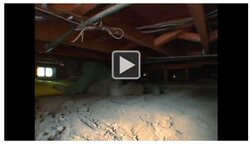I was wondering whether anyone has done this, or has had it done to their home's crawl space?
We have a ranch style home in the Cuyahoga River valley. We see high humidity levels all summer - we don't have central or forced air (propane boiler, I mean, ahem Harmon P35i ).
).
We have a crawl space under half of our house - the half with the bedrooms. Inside our back bedrooms we sometimes see mold growth on the inside of closet doors. We think it is our unsealed crawl space that is causing this issue. Not to mention a somewhat funky/musty smell.
We have about 1200 sq feet of crawl space, and it is mainly just dirt/gravel. Luckily it is dry - no standing water or water intrusion that I can find.
There are some products on the market called DrySpace and CleanSpace (Basement Systems) which essentially are really thick plastic sheets that are affixed to the walls, as high as the footers, and then run across the crawl space floor, overlapping, from one side to the other. The sheeting is thick enough that you can walk on it or store materials in there, without threat of tearing it for 25 years. All outside air vents are also sealed up. Apparently this is the latest thinking on crawl space treatment - they should not be open to outside air. Sometimes a large dehumidifier is also added.
The wife wants something done soon. We've lived here almost three years and the situation has remained. Not sure if I can get away with just laying some thick plastic sheeting across the crawl space or whether I need one of these fancy products.
Any experiences with these products or others?
We have a ranch style home in the Cuyahoga River valley. We see high humidity levels all summer - we don't have central or forced air (propane boiler, I mean, ahem Harmon P35i
 ).
). We have a crawl space under half of our house - the half with the bedrooms. Inside our back bedrooms we sometimes see mold growth on the inside of closet doors. We think it is our unsealed crawl space that is causing this issue. Not to mention a somewhat funky/musty smell.
We have about 1200 sq feet of crawl space, and it is mainly just dirt/gravel. Luckily it is dry - no standing water or water intrusion that I can find.
There are some products on the market called DrySpace and CleanSpace (Basement Systems) which essentially are really thick plastic sheets that are affixed to the walls, as high as the footers, and then run across the crawl space floor, overlapping, from one side to the other. The sheeting is thick enough that you can walk on it or store materials in there, without threat of tearing it for 25 years. All outside air vents are also sealed up. Apparently this is the latest thinking on crawl space treatment - they should not be open to outside air. Sometimes a large dehumidifier is also added.
The wife wants something done soon. We've lived here almost three years and the situation has remained. Not sure if I can get away with just laying some thick plastic sheeting across the crawl space or whether I need one of these fancy products.
Any experiences with these products or others?


